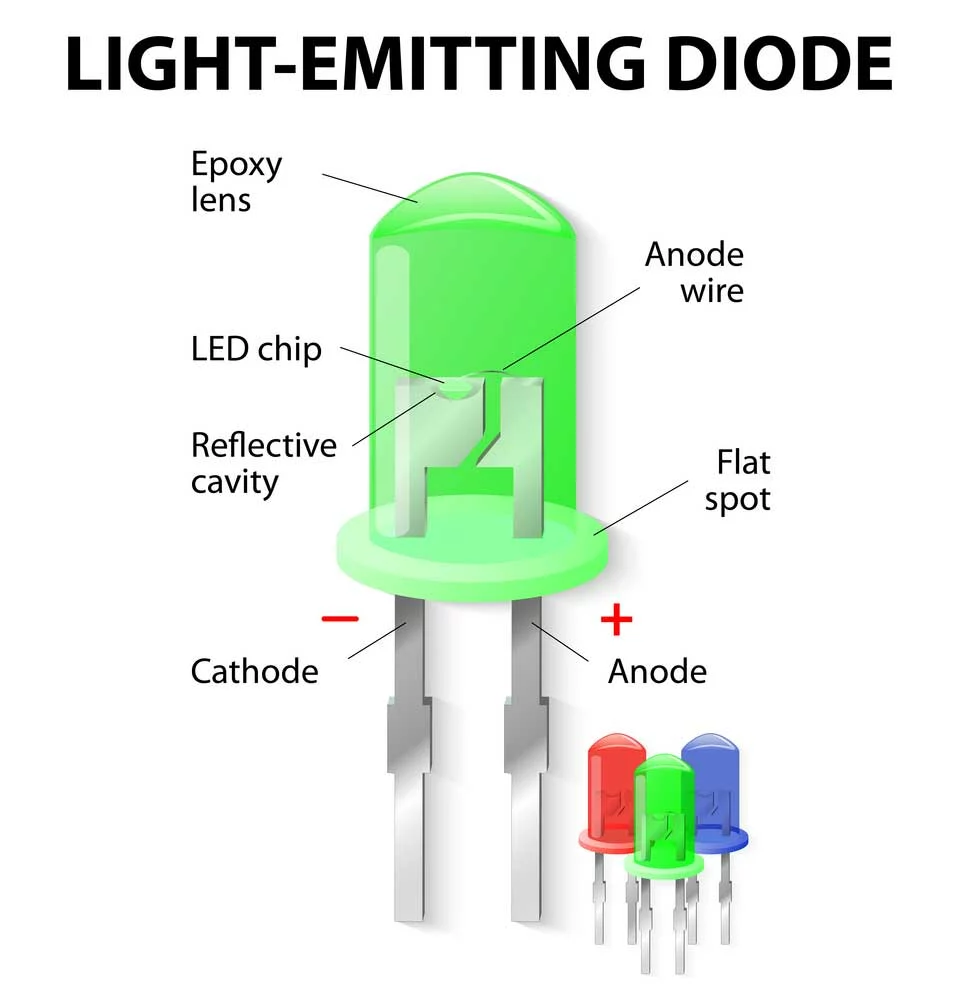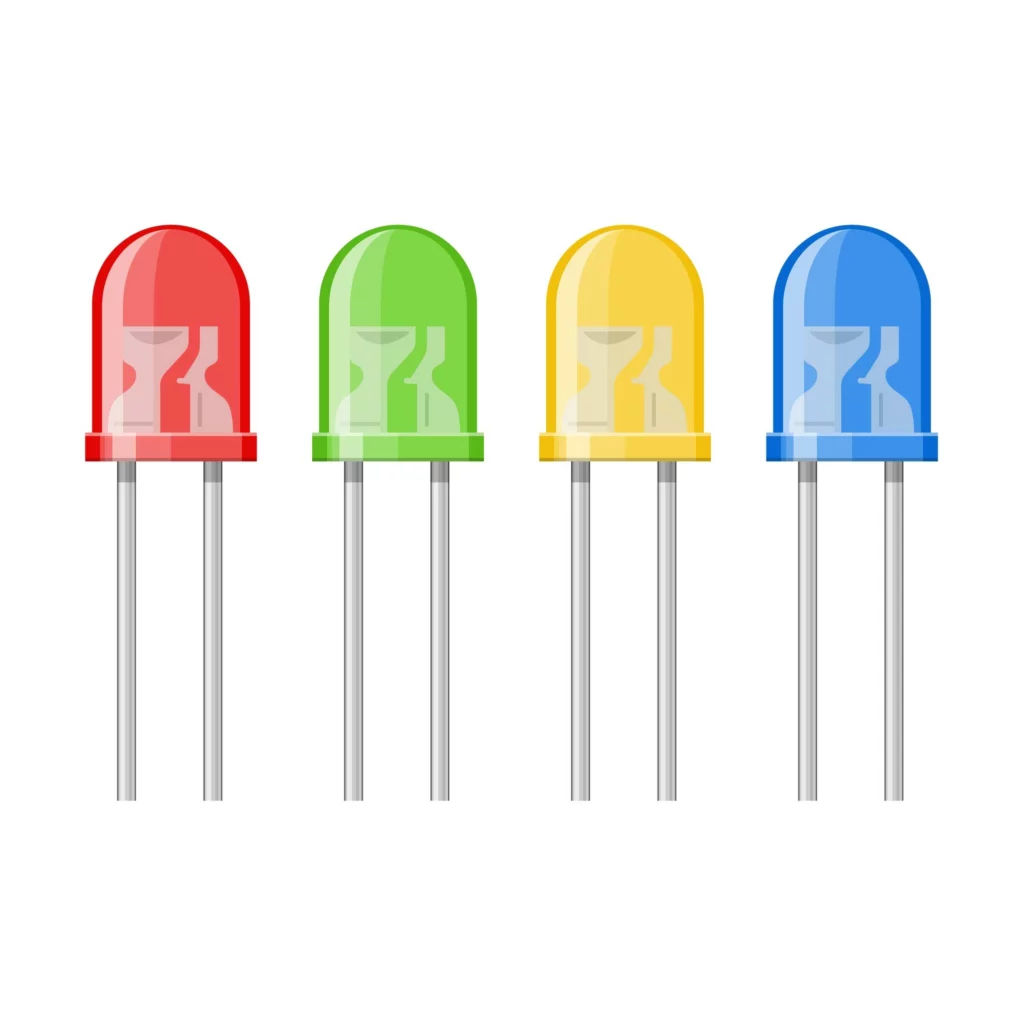Have you ever switched the direction of your component’s connection to make it work? Then, there’s a high chance that it’s related to polarity. Polarity is a crucial concept in electronics. While you can connect non-polarized components in any direction, polarized variants can only work in a specific order. So, how can you detect LED polarity? This article explores the different ways to find LED polarity and why it’s essential for your bulbs.
Are you ready? Let’s get started!
What is the Polarity of an LED?
LED Polarity
Diodes are unilateral devices that allow current flow in only one direction. And when it comes to polarity, LEDs are very similar. So, it means they’re always polarized.
Like their diode cousins, LEDs have two terminals (anode and cathode). So, the cathode is the negative terminal, while the anode is the positive one.
In LEDs, current can only flow from the anode to the cathode, which explains why connecting them in the right direction is crucial.
Further, every LED has some indication to determine the cathode or anode terminal.
How to Determine LED Polarity

LED diagram
There are multiple ways to detect an LED’s polarity. Let’s look at these methods and how they work.
Visual Indication 1: Terminal Length

LED terminal length
One easy way to determine LED polarity is the terminal length. New LEDs always have one terminal longer than the other, and it’s not a manufacturing error.
Its purpose is to help you decide which one is negative or positive. So, the longer term is the anode, while the shorter one is the cathode.
However, this method only works for brand-new LEDs. Hence, this method is ineffective if you’ve used the LEDs or some parts of the terminal are cut.
Visual Indication 2: Flat & Round Sides
LEDs don’t have the same sides. So, a closer look will show that one side is round and the other flat, which helps you determine the polarity. Here’s another easy visual method you can try if the first one doesn’t work.
The terminal next to the flat side is the anode, while the cathode is under the rounded side. Unlike the terminal length, this method always helps determine polarity. Plus, you won’t need any tools to check, only your eyes.
Visual Indication 3: Metal Plate Size

LED internal metal plates
One more visual method to try is the size of the metal plates inside the LED. If you look inside, you may see two metals, depending on your LED type.
One of these plates is bigger than the other, which also helps to indicate polarity. The smaller one connects to the anode, while the larger one links to the cathode. Although it’s a simple method, you’ll need to look closely or use a magnifier.
Sometimes, the larger plate may connect to the anode. But, such cases are rare, and there’s only a tiny chance this method won’t show the correct polarity. However, since LEDs have different designs, there’s no guarantee this method would work for all diodes.
Tool Indication 1: Multimeter

Multimeter
Multimeters are incredibly versatile tools that are a must-have for every DIYer or engineer. It can measure various values and save you some time when troubleshooting components. And they can check LED polarity.
Use the probes to touch the terminals and see if it lights. Switch the probes if it doesn’t glow. These tools have a diode function that can help determine polarity.
The terminal with the red probe is the anode, while the one with the black search is the cathode. The process is quick and easy, but you may not always have a multimeter. So, you can try the previous methods to determine the polarity on the go.
Tool Indication 2: Coin Cell Battery

Coin cell battery
While this is not necessarily a tool, a coin cell battery can help determine polarity. How? The battery is small enough to fit between both LED terminals.
You can opt for bigger batteries (like AA batteries), but it would require some cables for connections. Your LED should light up after placing the mortar between the LED terminals. And you can swap the position if it doesn’t.
The lead that touches the positive side of the battery is the anode, while the one on the negative side is the cathode. Interestingly, the same principle for bigger batteries.
Although this method is excellent, it’s not practical. Coin cell batteries are not so popular. Also, you won’t carry a battery and wires everywhere.
Why should you know the Polarity of your Bulb?

LED Bulb
LED bulbs also have polarity, meaning they won’t work if you don’t connect them correctly. These bulbs have at least two ends, including a negative and positive power contact and a semiconductor diode for generating light.
All parts of the bulb are essential for maximum performance. So, if your LED bulb has a wrong connection, it will either generate terrible lights and colors, get damaged, or fail to work.
But if your connection is correct, the positive contact will allow electricity to flow into the bulb, while the negative one will collect excess electrons to prevent overheating.
How to Identify LED Bulb Polarity
You can determine your LED bulb’s polarity in three ways. First, check your bulb’s packaging. If it’s horizontal, it means there’s no polarity.
Second, you can check for the “+” and “-” signs on each side of the bulb. If it’s present, the bulb has polarity. Third, examine your bulb’s terminals. It’s polarized if there are four pins in a square formation.
FAQs
What happens if an LED has backward wiring?
Most times, your lights won’t work. However, your LED could also explode or burn out. So, we don’t recommend wiring your components backward.
Will powering LEDs with AA batteries fry them?
There is a chance of damaging your LEDs if you use AA batteries. However, it only applies when you power it more than necessary without a series resistor.
Can you test LED polarity with a 9V battery?
Yes. But you’ll need to build a circuit with a 1k ohm resistor to avoid damaging your LEDs.
Rounding Up

LEDs
LEDs only allow current flow in one direction. So, knowing the correct way before making your connections is essential.
Like other diodes, LEDs have two terminals: a cathode (negative) and an anode (positive). And there are several ways to identify the terminals. We’ve listed five quick and easy methods in this article that’ll help you identify polarity.
Do you have any questions? Feel free to contact us, and we’ll be happy to help.
